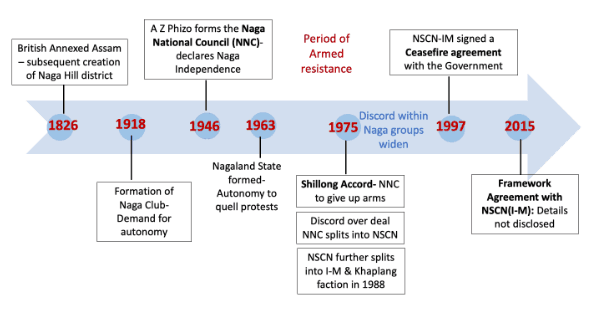NSCN-IM Threatens Armed Violence Over Naga Peace Deal
Why in the news?
The NSCN-IM, a key Naga insurgent group, has issued its first armed threat since 2015, accusing the Indian government of failing to honour the Naga peace agreement’s terms.
Recent Developments and Threats
- The NSCN-IM, led by T. Muivah, has issued a warning to “resume violent armed resistance” if the Indian government does not address their core demands, which include a separate flag and constitution for the
- This is the first such threat since the 2015 framework agreement, signed in the presence of Prime Minister Modi, aimed at ensuring peace and resolving long-standing Naga issues.
Accusations Against the Indian Government:
- The NSCN-IM accused the government of “deliberate betrayal” of the 2015 agreement by disregarding key commitments, particularly the recognition of the Naga flag and constitution.
- The group claims that government authorities and leaders are pushing for terms that demand their surrender, a stance NSCN-IM firmly opposes, calling it a breach of mutual trust.
Background and Core Demands:
- The NSCN-IM, since its ceasefire with the Centre in 1997, has advocated for the creation of a “Greater Nagaland” or “Nagalim,” encompassing Naga-dominated regions in Assam, Manipur, and Arunachal Pradesh to unify 2 million Nagas.
- Recent actions within NSCN-IM, including the appointment of Pamshin Muivah as National Security Adviser, highlight the organisation’s resolve to defend its territorial, historical, and cultural identity through all means if necessary.
About Naga Insurgency and Related Issues:
- Nagas: Indigenous Indo-Mongoloid community residing in northeastern India and Myanmar, believed to have migrated in the 10th century BC.
- Historical Background:
- Came under British rule in the 19th century; assisted British forces in WWII.
- NNC (1946) sought sovereignty, declared independence in 1947; later formed NFG and NFA in 1952.
- NSCN formed post-Shillong Accord (1975), split into NSCN-IM and NSCN-K in 1988.
- Key Demands: A “Greater Nagalim” with Naga-dominated regions from Manipur, Assam, Arunachal Pradesh, and Myanmar; a separate constitution and national flag.
- Peace Efforts:Shillong Accord (1975), Ceasefire (1997), Framework Agreement (2015) recognizing Naga identity and aspirations.
Sources Referred:
PIB, The Hindu, Indian Express, Hindustan Times




